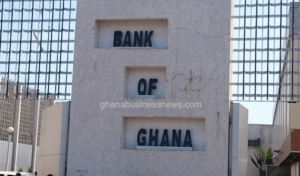Bank of Ghana maintains policy rate at 16%, as banking sector deposits hit GH¢83b
 The Bank of Ghana considering that the synchronised slowdown in the global economy during 2019 is beginning to give way to a recovery, mainly in the emerging market and developing economies and at a modest and uneven pace, and taking into account the coordinated monetary policy responses of the major central banks to keep interest rates on hold and adopt a dovish monetary policy stance which is expected to benefit emerging market economies with solid macroeconomic fundamentals, has maintained the policy rate at 16 per cent.
The Bank of Ghana considering that the synchronised slowdown in the global economy during 2019 is beginning to give way to a recovery, mainly in the emerging market and developing economies and at a modest and uneven pace, and taking into account the coordinated monetary policy responses of the major central banks to keep interest rates on hold and adopt a dovish monetary policy stance which is expected to benefit emerging market economies with solid macroeconomic fundamentals, has maintained the policy rate at 16 per cent.
In a press statement issued today in Accra, the central bank notes that on the domestic economy, the latest data from the Ghana Statistical Service and the Bank’s Composite Index of Economic Activity both show that economic growth continues to remain robust and broad-based, although at a moderated pace relative to 2018.
“Consumer confidence has rebounded and businesses are fairly optimistic about industry prospects. Strong growth in monetary aggregates reflects significant pickup in aggregate demand, buoyed by a rebound in private sector credit, following the clean-up of the banking sector. Over the medium term, growth will be supported by the services sector, especially as the banking sector continues to grow stronger and resilient, as well as the continued implementation of growth-oriented programmes in the industry and agricultural sectors of the economy,” it said.
According to the Bank, total assets of the banking sector increased to GH¢129.06 billion at end December 2019, representing a 22.8 percent year-on-year growth.
“The increased total assets was on account of significant growth of 22.2 per cent year-on-year in deposits to GH¢83.46 billion underscoring renewed confidence in the banking sector,” it said.
The Bank notes further that the industry’s Capital Adequacy Ratio, computed in accordance with the Capital Requirement Directive under the Basel II/III capital framework, stood at 17.5 per cent at the end of December 2019, and above the 13 per cent minimum regulatory benchmark. Asset quality also improved significantly and the NPL ratio declined sharply to 13.9 percent in December 2019 from 18.2 per cent in December 2018, reflecting increased loan recoveries, write-offs, and higher credit growth.
By Emmanuel K. Dogbevi
